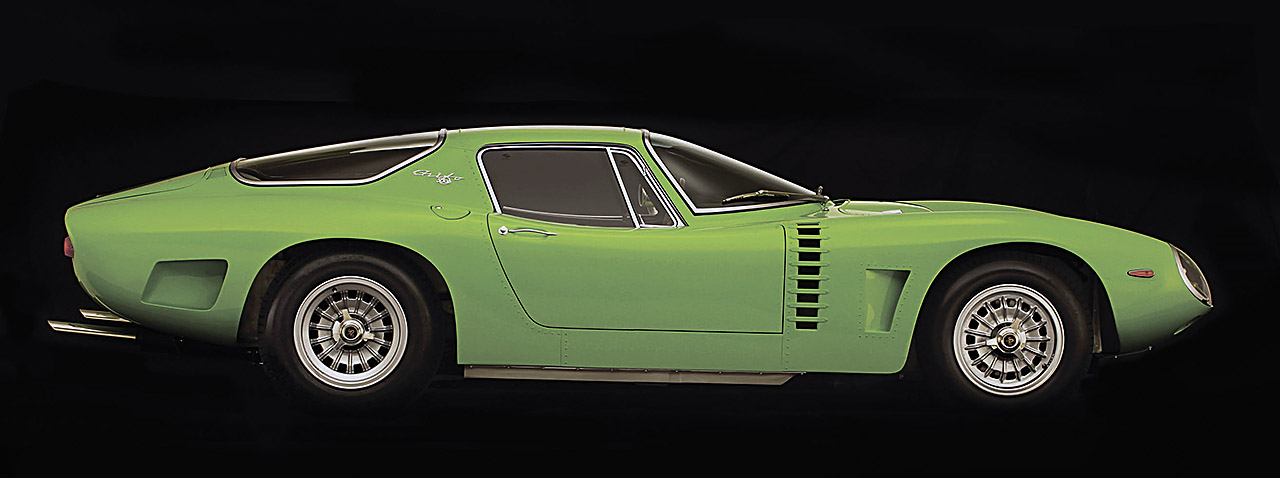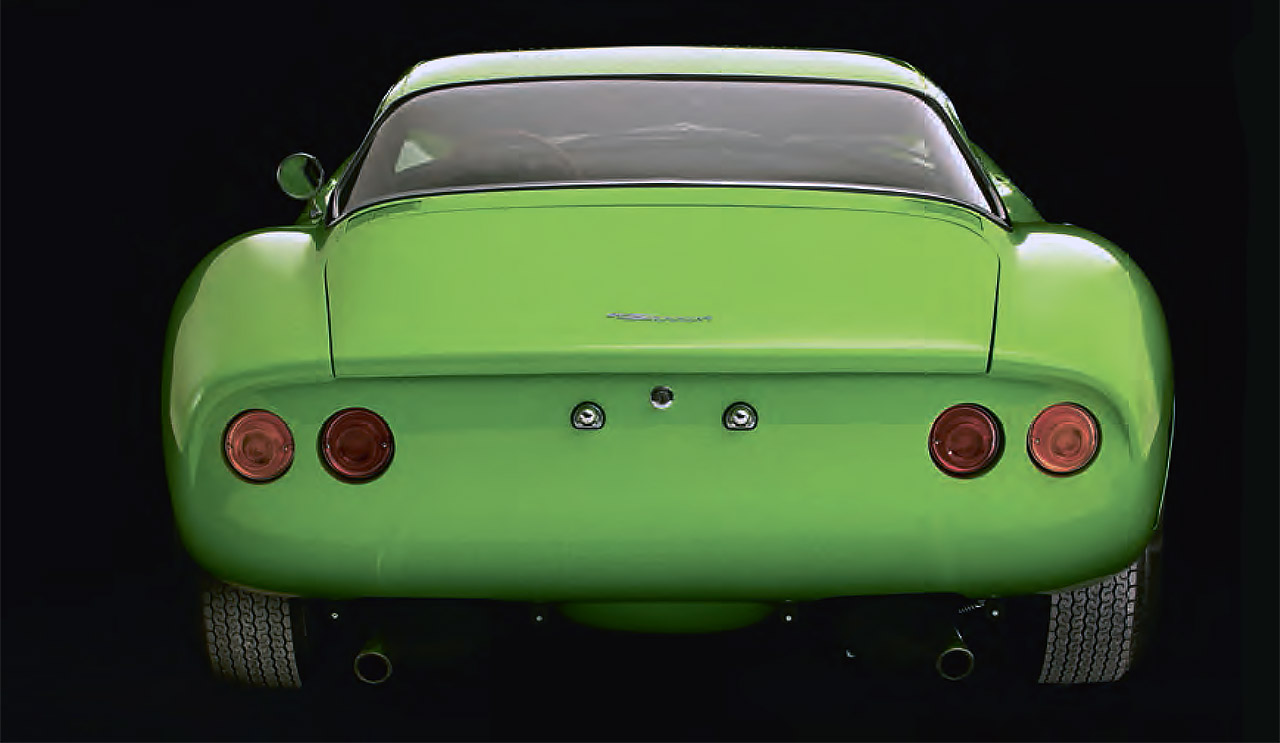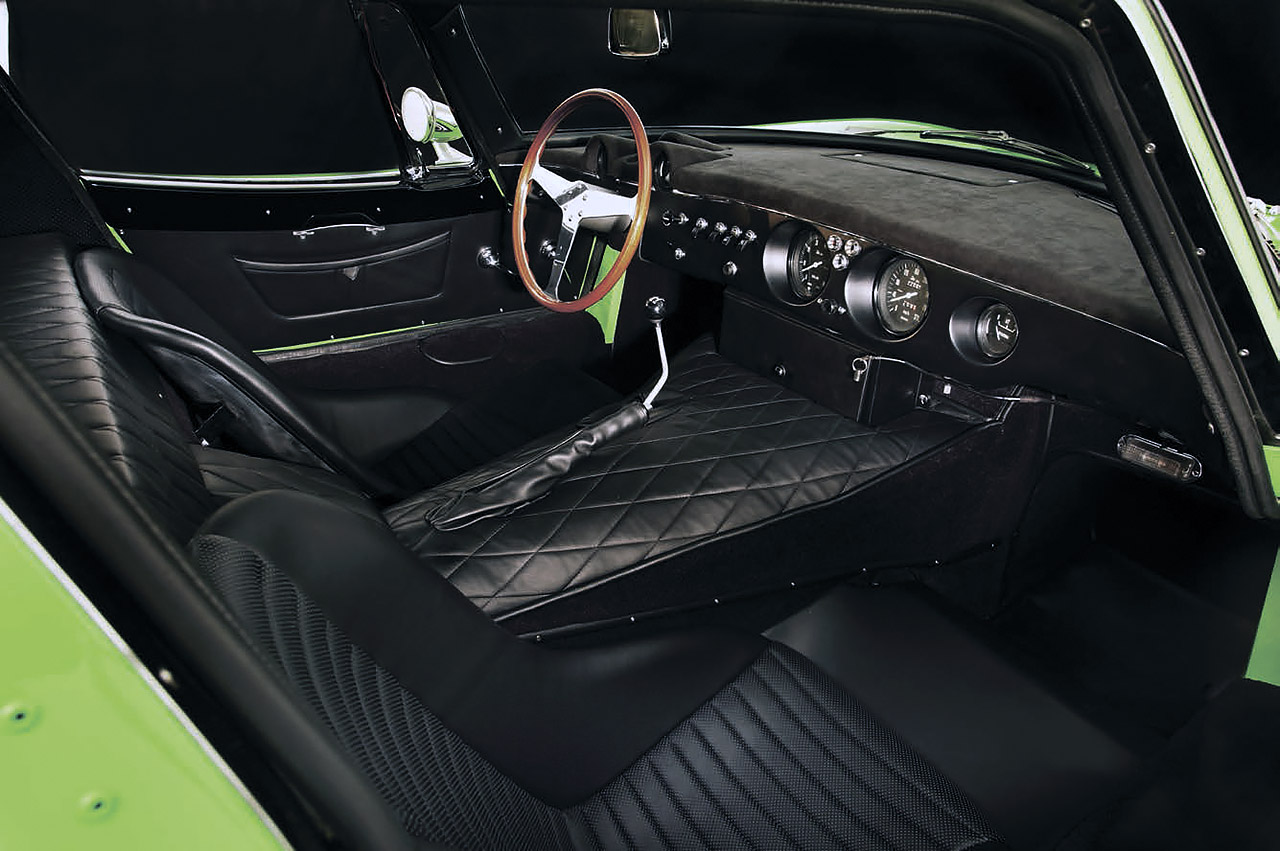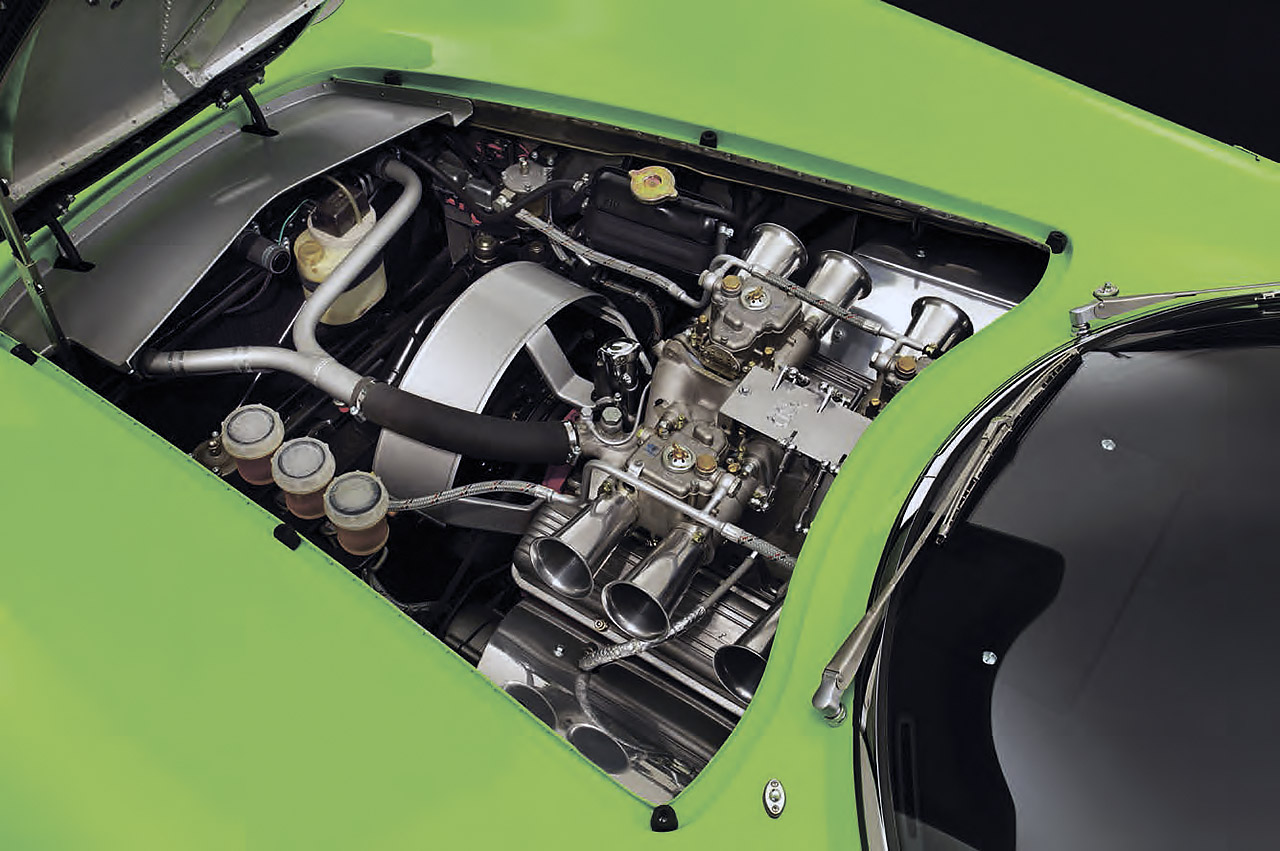
Wild Thing. Outrageous Iso A3/C Bizzarrini’s road-racer. ISO A3/C in profile Giotto Bizzarrini’s jaw-dropping GT. Richard Heseltine tells the remarkable story of renegade engineer Giotto Bizzarrini and the sensational gran turismo that he devised. Photography James Mann.
It assaults your eyes and rattles your senses. Low, wide and slab of side, the Iso A3/C appears impossibly exotic: a car that packs a visual punch along with a kick and a head-butt. That vast acreage of bonnet – curve begetting curve – is intersected by a shallow windscreen, the low beltline, dramatically tapered roofline and aggressively arched rear haunches arriving at an oh-so-period cropped tail. If the exposed rivet heads aren’t enough to alert you to its competition heritage, the profusion of air outlets leaves you in no doubt. It’s almost cartoonishly exaggerated, all flared nostrils and ‘just try me’ posturing. Resplendent in eye-watering Mela Verde (Apple Green), it is nothing if not noticeable.

Giorgetto Giugiaro turned draughtsman Piero Vanni’s proposal into this stunning form; lurid Mela Verde was original colour, confirmed during resto; 7000 rivets were used in the body!
Which is to be expected of a car created by the notoriously self-directed Giotto Bizzarrini, an engineer who is either a genius or an ungovernable rebel depending on whose opinion you canvas. Perhaps even both. His name is writ large in motorsport and supercar lore and with good reason. The Tuscan’s curriculum vitae is long and packed with intrigue, that’s for sure.
A graduate from the University of Pisa, Bizzarrini’s maiden effort was a Fiat Topolino based special that was completed while he was barely out of his teens. At Alfa Romeo, he worked on what in time became the Giulietta before joining Ferrari in 1957. His name would become inextricably linked with the 250GTO, but he had left the Scuderia’s employ by the time it made its presence felt on track. Bizzarrini was one of the key instigators behind the infamous ‘palace revolt’ in 1961 and left shortly after. He subsequently joined fellow mutineers in establishing the rival ATS squad, only to depart for another start-up operation almost immediately.

Low-slung A3/C is just over 43in tall. Below: need for extra saddle fuel tanks dictated shape of rear; maker’s badge on snout; stylish coachbuilder’s plate of Sports Cars Modena; spindly, weightsaving Doorhandle.
Ferruccio Lamborghini engaged the then freelance ingegnere to conceive a new V12 for his forthcoming 350GT. Bizzarrini rustled up an engine in just four months, but it was left to Gian Paolo Dallara to refine his design before it was fit for production. Disagreements with his paymaster led to Bizzarrini lending his talents to another recently minted marque: Iso.
Renzo Rivolta had made his fortune manufacturing fridges and microcars before moving on to something a bit more exclusive: a gran turismo bearing his surname. Bizzarrini was employed as a consultant to Iso and, being a racer to the core, he soon began petitioning for a competition model. From his Società Autostar facility in Livorno, and working closely with Iso’s engineering chief Pierluigi Raggi, he took an Iso Rivolta rolling chassis and shortened it. He then moved the small-block Chevy V8 further back towards the centre. The body, meanwhile, was sketched out by draughtsman Piero Vanni, his drawings in turn being handed over to Nuccio Bertone’s eponymous design house.
From all accounts, Bertone was horrified by what he saw. Nonetheless, stylist Giorgetto Giugiaro reinterpreted Vanni’s efforts as best he could but that was where Stile Bertone’s involvement ended. Full-scale drawings were passed to Piero Drogo’s Sports Car Modena concern. A skeletal substructure was then created, onto which the body was hung. Held together with the aid of 7000 rivets, it was completed in time for the big unveiling at the 1963 Turin Salon, where the prototype shared a stand with fellow debutant, the Iso Grifo. But there was a problem. There had been insufficient time to paint the car so Bizzarrini had its bare aluminium skin buffed with cork, which resulted in a distinctive – if not overly attractive – swirling effect.

Reaction to the A3/C Grifo, as it was dubbed, was such that there were calls for a road-going version, but first things first: Iso was going racing. Cars were campaigned across Europe in ’64, the highpoint of what was for the most part a disappointing season being class honours in the Le Mans 24 Hours (Bizzarrini drove the car to France and back). It was a costly undertaking, and Renzo Rivolta wasn’t convinced a race programme was worth the expenditure, which inevitably led to friction between the two. Matters took a further turn as Bizzarrini and Drogo fell out, so boat-builder Catarsi and Carrozzeria BBM were roped in to make shells.
Production of the A3/C was hesitant at best, the car pictured here being one of about 15-20 made. It was constructed in 1965, a season that, save for another class win at Le Mans, was largely free of success, which hastened the split between engineer and patron. Bizzarrini had an ace up his sleeve, though. Cannily, he had registered the name Grifo. A deal was then struck whereby Rivolta got the name of his range-topper back and, in return, Bizzarrini was guaranteed a supply of enough parts to build a further 50 cars. And thus, Bizzarrini the marque was born.
Two models were offered: the GT Strada 5300 and GT America. The latter variant, as the name suggests, was intended for the US market. It featured glassfibre bodywork and independent rear suspension in place of the Strada’s de Dion set-up. Racing legend John Fitch initially ran the concession, but it was a short-lived relationship.

Wood-rimmed wheel is only extravagance in the purposeful cockpit; rev counter and speedo in dash centre. Below: scriptstyle Grifo badge; wing vents are as per racer.
The day-to-day realities of being a car manufacturer soon began to tell, and it became clear that Bizzarrini wasn’t a businessman. Aftermarket support was practically non-existent and, just to make life even more difficult for himself, he introduced a further variation on the theme – the pretty 5300 Spider SI – but it too failed to take flight. The same was true of the GT 1900 Europa, a scaled-down coupé that featured Opel or Fiat running gear Wrong-footed by homologation changes, his mid-engined P538 racer was foiled having barely left the starting blocks and, in 1967, Bizzarrini SpA lurched into receivership. Worse was to come. The sister firm, Prototipo Bizzarrini Srl, was incorporated into another business, but potential saviours turned out to be nothing of the kind. New ‘investors’ used assets as collateral and promptly disappeared with their booty.
By 1969, it was all over. A mere 139 V8 GTs of all types had been made. That said, given the jumps in chassis numbers, this figure is likely to be optimistic, but nothing about the marque – or the car that sired it – is ever straightforward. First of all, there are a few examples circulating with dubious histories while others were reconfigured in period, which further muddies the water. ‘Our’ car, for instance, has continuous history from day one, but its story is far from linear.

From main: overhead shot shows just how far back the V8 sits in the chassis – dash panel gives access to distributor; recessed rear lamps; maker’s badge also adorns the wheel spinners.
Chassis B 0216 was sold new in Germany in 1965 via Auto Becker, a well-known supplier of high-end performance cars. The A3/C featured the same riveted aluminium bodywork as a racer, most likely fashioned by Drogo. According to a previous keeper, the car was involved in an accident a few years into its life and was subsequently dispatched to the Bizzarrini works. There it received updates and a new interior in line with the GT Strada. The rivets were filled in and the car was painted black. It also received a new chassis (IA3 0283) and was sold thereafter, possibly as a new car. The Iso subsequently passed through several owners in more than one country, before surfacing in Florida in the late ’70s.
Scroll forward to 2003 and the Iso’s previous identity was revealed. The 1965 chassis number was clearly visible and it was at this juncture that the car regained its factory guise as B 0216. The Iso received something of a makeover, being returned to its initial configuration, although the wing vents are more in keeping with the factory racers. In 2010, it underwent a body-off restoration by Autocostruzioni SD of Turin, company boss Salvatore Diomante having been Bizzarrini’s workshop manager during the ’60s.
‘THERE AREN’T MANY CARS THAT COULD UPSTAGE A LIME GREEN MIURA, BUT THIS IS ONE’
It’s hard not to stare open mouthed at the end result. Much of this is down to the highlighter pen hue, which is believed to have been the original colour (traces were found during the resto). There aren’t many cars that can upstage a lime green Lamborghini Miura, but this is one. The Iso screams excess, without any sort of subtlety to it. It seems gloriously over the top, but the more you look, the more you appreciate the thinking behind it and drink in the details.
It’s a stretch to call the Iso beautiful, but it’s undeniably sexy. The proportions are a little off in places, the flattened flanks being a by-product of the need for supplementary saddle tanks, while the peak of the roof stands just 43¼in off the deck. As such, it looks a little skew-whiff, but it’s achingly attractive from certain angles. The sense of purpose is palpable, the car’s competition roots showing through all the more on stepping aboard. This is no easy task because the wide sill makes access difficult and, once in, you find yourself sharing cabin space with much of the 327cu in V8. Bizzarrini had originally envisaged the Iso as a mid-engined car and, in essence, it is – even if the Detroit slugger nominally remains in the front (there’s a removal panel atop the dashboard for access to the distributor).

It is nowhere near as cramped as you might imagine, though. It’s a wide car – 68in across – and surprisingly comfortable with it. That said, you are forced to adopt a semi-reclined driving position although that’s no hardship; and is to be expected. The massive transmission tunnel, which is clad in quilted vinyl, in effect divides the cabin in half. The dashboard is businesslike, which is in keeping with its racer intent. There is little in the way of decorative flourishes – save the wood-rimmed wheel – with your point of focus being the central rev counter and speedo, both of which are angled towards the driver.
Inevitably, the Iso is bound to polarise opinion. Much of this is down to its transatlantic lump. Those who expect their Italian exotica to be twelve-cylindered and pure-bred might turn up their noses but, over the past decade or so, the A3/C – and by extension its Bizzarrini-badged offspring – has undergone an image overhaul. Giotto Bizzarrini is quoted as saying that the Iso was a natural evolution of the 250GTO and, given the numbers of wins that it has accrued in historics, perhaps this isn’t such a fanciful idea. What’s more, the use of American firepower made so much sense. Why spend a fortune developing an engine from scratch when one was available off the shelf that provided prodigious amounts of power and low-stressed reliability?
Ultimately, the Iso and the cars it spawned were undone by so many factors, the lack of a business plan being just one of them. After the dust settled on volume production – all things being relative – Giotto Bizzarrini regrouped and became embroiled in the American Motors Corporation plan to build a supercar, but sadly the AMX/3 was never made in series. There was the odd Bizzarrini concept, and remarkably two further spells at Iso. A few ‘continuation’ cars were made on occasion but, hounded by creditors, Bizzarrini found greater stability passing on his experience in academia. You could argue that his career had come full circle.
And what a career. The Iso reflects its creator in that it’s a racer at heart. That, plus its brilliance in parts, and being a bit leftfield in others, means that it’s appreciated more in retrospect. Which would explain the €1,036,000 realised when ‘The Green Apple’ went under the hammer at RM’s Rétromobile auction last month. The Iso’s day had come, albeit half a century late.





